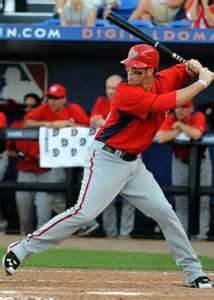Baseball
Swing- Momentum
The
baseball swing has many parts to it that are
physics driven. The transfer of mass
when preparing for the pitch, called momentum,
gives the player more power towards the
swing. The player below, Bryce Harper,
is shown transferring his weight by rocking on
his back foot, then pushing forward when the
ball is thrown. The momentum from his
body and from the baseball bat combine to hit
the baseball.
 Linear Motion -
P(momentum)=M(mass)*V(velocity)
Linear Motion -
P(momentum)=M(mass)*V(velocity)
http://voices.washingtonpost.com/nationalsjournal/bryce.jpg
Rotational
Motion- L(Momentum)=
I(Inertia)*w(Angular Velocity)
Momentum in a closed system is always
conserved! But is a baseball game a
closed system? NO!!
The contact between the ball and the bat
causes friction, turning kinetic energy from
the momentum into thermal
energy. the air resistance on the
bat is small, but as it moves through the air
it gives off thermal energy from the friction.
Because of conservation of momentum, when you
swing the bat faster (V) or (w) and you are
heavier (M) or smaller Inertia (I), the
baseball you hit will have a similar
momentum. Also, if you move yourself
with a greater velocity, angular or linear and
are heavier with a smaller inertia, you will
have a larger momentum acting on the
ball.
"Just think about throwing a ball against a
solid wall. The harder you throw the
ball against the wall, the harder it bounces
back. that is the reason it is easier to
hit a homerun on a fastball than on a
curveball." (1)
|